Olympic flame

The Olympic flame is a symbol of the Olympic Games.[1] Commemorating the theft of fire from the Greek god Zeus by Prometheus, its origins lie in ancient Greece, where a fire was kept burning throughout the celebration of the ancient Olympics. The fire was introduced at the Games of the IX Olympiad 1928 in Amsterdam and it has been part of the modern Olympic Games ever since. The first fire of the Olympic Winter Games was introduced at the IV Olympic Winter Games 1936 in Garmisch-Partenkirchen.
In contrast to the Olympic flame proper, the torch relay of modern times, which transports the flame from Greece to the various designated sites of the games, had no ancient precedent and was introduced by Carl Diem at the 1936 Summer Olympics in Berlin.[2]
Usage
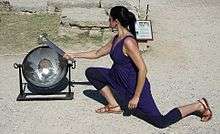
The Olympic Torch today is ignited several months before the opening ceremony of the Olympic Games at the site of the ancient Olympics in Olympia, Greece. Eleven women, representing the Vestal Virgins,[notes 1] perform a celebration at the Temple of Hera in which the torch is kindled by the light of the Sun, its rays concentrated by a parabolic mirror. The torch briefly travels around Greece via short relay, and then starts its transfer to the host city after a ceremony in the Panathenaic Stadium in Athens.[3][4] The Olympic Torch Relay ends on the day of the opening ceremony in the central stadium of the Games. The final carrier is often kept unannounced until the last moment, and is usually a sports celebrity of the host country. The final bearer of the torch runs towards the cauldron, often placed at the top of a grand staircase, and then uses the torch to start the flame in the arena. It is considered to be a great honor to be asked to light the Olympic flame. After being lit, the flame continues to burn throughout the Games, until the day of the closing ceremony and celebration, when it is finally put out, symbolizing the official end of the Games.
History
Ancient Olympics
In the time of the original games within the boundaries of Olympia, the altar of the sanctuary dedicated to the goddess Hestia maintained a continuous flame.[5][6] For the ancient Greeks, fire had divine connotations—it was thought to have been stolen from the gods by Prometheus. Therefore, fire was also present at many of the sanctuaries in Olympia, Greece. During the Olympic Games, which honoured Zeus, additional fires were lit at his temple and that of his wife, Hera. The modern Olympic flame is ignited at the site where the temple of Hera used to stand.
Modern era
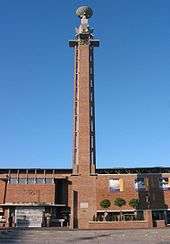

The tradition was reintroduced during the 1928 Games. An employee of the Electric Utility of Amsterdam lit the first Olympic flame in the Marathon Tower of the Olympic Stadium in Amsterdam.[7] The modern convention of moving the Olympic flame via a relay system from Greece to the Olympic venue began in 1936 in Germany. Carl Diem devised the idea of the torch relay for the 1936 Summer Olympics in Berlin that was organized by the Nazis under the guidance of Joseph Goebbels. The Krupp armaments company produced the torches in wood and metal, inspired by an olive leaf. The Olympic flame was lit by a concave mirror in Olympia, Greece and transported over 3,187 kilometres by 3,331 runners in twelve days and eleven nights from Greece to Berlin. Leni Riefenstahl later staged the torch relay for the 1938 film Olympia. Adolf Hitler saw the link with the ancient Games as the perfect way to illustrate his belief that classical Greece was an Aryan forerunner of the modern German Reich.[8] There were minor protests in Yugoslavia and Czechoslovakia on the way, which were suppressed by the local security forces.
Although most of the time the torch with the Olympic flame is still carried by runners, it has been transported in many different ways. The fire travelled by boat in 1948 and 2012 to cross the English Channel and was carried by rowers in Canberra as well as by dragon boat in Hong Kong[9] in 2008, and it was first transported by airplane in 1952, when the fire travelled to Helsinki. In 1956, all carriers in the torch relay to Stockholm, where the equestrian events were held instead of in Melbourne, travelled on horseback. Remarkable means of transportation were used in 1976, when the flame was transformed to a radio signal. From Athens, this signal was transmitted by satellite to Canada,[10] where it was received and used to trigger a laser beam to re-light the flame. This distinctive 1976 torch was manufactured by John L. Saksun's The Queensway Machine Products Ltd. In 2000, the torch was carried under the water by divers near the Great Barrier Reef. Other unique means of transportation include a Native American canoe, a camel, and Concorde.[11] In 2004, the first global torch relay was undertaken, a journey that lasted 78 days. The Olympic flame covered a distance of more than 78,000 km in the hands of some 11,300 torchbearers, travelling to Africa and South America for the first time, visiting all previous Olympic cities and finally returning to Athens for the 2004 Summer Olympics.
The climactic transfer of the flame from the torches to the cauldron at the host stadium concludes the relay and marks the symbolic commencement of the Games. Perhaps one of the most spectacular of these ceremonies took place at the 1992 Barcelona Games, when Paralympic archer Antonio Rebollo ignited the cauldron by shooting a burning arrow over it, which ignited gas rising from the cauldron.[12] Two years later, the Olympic fire was brought into the stadium of Lillehammer by a ski jumper. In Beijing 2008, Li Ning "ran" on air around the Bird's Nest and lit the flame. In Vancouver 2010, four athletes—Catriona Le May Doan, Wayne Gretzky, Steve Nash and Nancy Greene—were given the honour of lighting the flame simultaneously (indoors) before Wayne Gretzky transferred the flame to an outdoor cauldron at Vancouver's waterfront. Two years later, at the 2012 Summer Olympics in London, seven young athletes-Callum Airlie, Jordan Duckitt, Desiree Henry, Katie Kirk, Cameron MacRitchie, Aidan Reynolds and Adelle Tracey were given the honour of lighting the flame on one of the 204 copper petals before they converged to form the cauldron for the Games.
Lighters
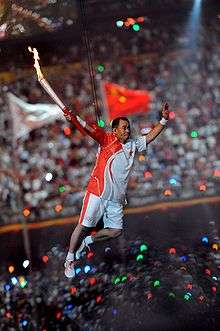
Over the years, it has become a tradition to let famous athletes, former athletes and/or athletes with significant achievements and milestones be the last runner in the Olympic torch relay and have the honour of lighting the Olympic Cauldron. The first well-known athlete to light the cauldron in the stadium was ninefold Olympic Champion Paavo Nurmi, who excited the home crowd in Helsinki in 1952. Other famous last bearers of the torch include heavyweight boxing champion Muhammad Ali (1996), Australian aboriginal runner Cathy Freeman (2000), ice hockey player Wayne Gretzky (2010), and Brazilian marathon runner Vanderlei de Lima (2016).
On other occasions, the people who lit the cauldron in the stadium are not famous, but nevertheless symbolize Olympic ideals. Japanese runner Yoshinori Sakai was born in Hiroshima on 6 August 1945, the day the nuclear weapon Little Boy destroyed that city. He symbolized the rebirth of Japan after the Second World War when he opened the 1964 Tokyo Games. At the 1976 Games in Montreal, two teenagers — one from the French-speaking part of the country, one from the English-speaking part — symbolized the unity of Canada. For the 2012 Games in London, seven aspiring young athletes — each nominated by a British Olympic hero — had the honour of lighting the cauldron.
In 1968, Enriqueta Basilio became the first woman to light the Olympic Cauldron at the Olympic Games in Mexico City.
Routes
The Olympic torch travels routes that symbolise human achievement. As part of the 1976 relay the flame was transmitted from Greece to the New World via satellite. Heat sensors in Greece detected the flame, the signal was sent to Ottawa via satellite and there a laser beam lit the torch.[13] The torch, but not the flame, was taken into space by astronauts in 1996, 2000 and 2013.[14]
The 2008 Summer Olympics torch relay spanned all six inhabited continents before proceeding through China, but was met with protests in London, Paris, and San Francisco. As a result, in 2009, the International Olympic Committee announced that future torch relays could be held only within the country hosting the Olympics after the initial Greek leg. Although this rule took effect with the 2014 Winter Olympics, the organizers of the 2010 Winter Olympics in Vancouver and the 2012 Summer Olympics in London chose to hold their torch relays only in their respective hosting countries of Canada and the United Kingdom[15] (except for brief stops in the United States and Ireland, respectively). The London 2012 torch travelled 8,000 miles across the UK. The Rio 2016 torch travelled 12,000 miles across Brazil.
Torches
The design of the torch used in the relay to the Games changes for each Games. They may be designed to represent a classical ideal, or to represent some local aspect of those particular Games.[16][17][18] Some, such as Albertville in 1992 and Turin in 2006 have been designed by famous industrial designers. These design-led torches have been less popular than the more classical designs, the Turin torch in particular was criticised for being simply too heavy for the runners. The torch for the 1948 London Olympics was designed by architect Ralph Lavers.[19] They were cast in Hiduminium aluminium alloy[20] with a length of 47 cm and a weight of 960 g. This classical design of a long handle capped by a cylindrical bowl re-appeared in many later torch designs. The torch used for the final entry to the stadium and the lighting of the cauldron was of a different design, also a feature that would re-appear in later years. This torch did not require the long distance duration or weather resistance of the other torches, but did need a spectacular flame for the opening ceremony. At the Melbourne Olympics of 1956, the magnesium/aluminium fuel used for the final torch was certainly spectacular, but also injured its holder.[21] Runners were also burned by the solid-fueled torch for the 1968 Mexico Games. The fuel used for the torch has varied. Early torches used solid or liquid fuels, including olive oil.[22]
For a particularly bright display, pyrotechnic compounds and even burning metals have been used. Since the Munich Games of 1972, most torches have instead used a liquefied gas such as propylene or a propane/butane mixture. These are easily stored, easily controlled and give a brightly luminous flame. The number of torches made has varied from, for example, 22 for Helsinki in 1952, 6,200 for the 1980 Moscow Games[16] and 8,000 for the London 2012 Games. In transit, the flame sometimes travels by air. A version of the miner's safety lamp is used, kept alight in the air. These lamps are also used during the relay, as a back-up in case the primary torch goes out. This has happened before several Games, but the torch is simply re-lit and carries on.
The torch has been carried across water; the 1968 Grenoble Winter Games was carried across the port of Marseilles by a diver holding it aloft above the water.[16] In 2000, an underwater flare was used by a diver across the Great Barrier Reef en route to the Sydney Games.[21] In 2012 it was carried by boat across Bristol harbour in the UK and on the front of a London Underground train to Wimbledon.
The latest torch was designed by Edward Barber and Jay Osgerby for the 2012 London Games. Despite a deeply cynical response to the logo and mascots of the London Games, this torch design appears to have been well accepted in the UK and internationally.[23]
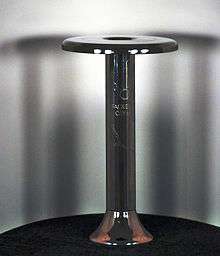 Berlin 1936 torch
Berlin 1936 torch- London 1948 torch
- Melbourne 1956 torch
 Rome 1960 torch
Rome 1960 torch- Tokyo 1964 torch
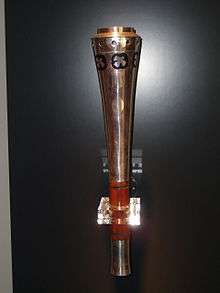 Mexico 1968 torch
Mexico 1968 torch- Munich 1972 torch
 Innsbruck 1976 torch
Innsbruck 1976 torch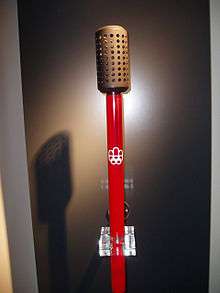 Montreal 1976 torch
Montreal 1976 torch- Lake Placid 1980 torch
 Moscow 1980 torch
Moscow 1980 torch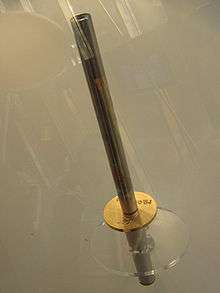 Sarajevo 1984 torch
Sarajevo 1984 torch- Los Angeles 1984 torch
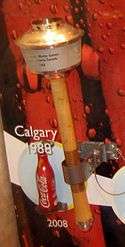 Calgary 1988 torch
Calgary 1988 torch- Seoul 1988 torch
 Barcelona 1992 torch
Barcelona 1992 torch.jpg) Atlanta 1996 torch
Atlanta 1996 torch- Nagano 1998 torch
- Sydney 2000 torch
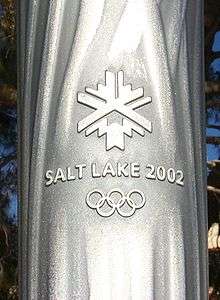 Salt Lake 2002 torch
Salt Lake 2002 torch Athens 2004 torch
Athens 2004 torch Turin 2006 torch
Turin 2006 torch Beijing 2008 torch
Beijing 2008 torch Vancouver 2010 torch
Vancouver 2010 torch London 2012 torch
London 2012 torch.png) Sochi 2014 torch
Sochi 2014 torch Rio 2016 torch
Rio 2016 torch
Protests
There have been protests against the Olympic flame relay. In the 1956 Melbourne Games in Australia, local veterinary student Barry Larkin protested against the relay when he tricked onlookers by carrying a fake flame, consisting of a pair of underpants set on fire in a plum pudding can, attached to a chair leg. He successfully managed to hand over the fake flame to the Mayor of Sydney, Pat Hills and escape without being noticed.[24][25][26] In 2008 there were various attempts to stop the Olympic flame as a protest against China's human rights record. In London, a "ring of steel" was formed around the flame to protect it, but one protester managed to grab hold of the torch while it was being held by television presenter Konnie Huq.[27]
In 2016, ten days before the beginning of the Rio Games in Brazil, citizens of Angra dos Reis, a small city near Rio de Janeiro, managed to put out the Olympic Flame when protesting against the city's spending money on hosting the games, despite the economic crisis that took hold of Brazil.[28]
Reigniting the flame
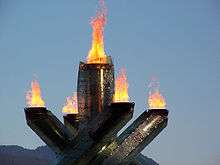
It is not uncommon for the Olympic flame to be accidentally or deliberately extinguished during the course of the relay, and on at least one occasion the cauldron itself has gone out during the Games. To guard against this eventuality, multiple copies of the flame are transported with the relay or maintained in backup locations. When a torch goes out, it is re-lit (or another torch is lit) from one of the backup sources. Thus, the fires contained in the torches and Olympic cauldrons all trace a common lineage back to the same Olympia lighting ceremony. One of the more memorable extinguishings occurred at the 1976 Summer Olympics held in Montreal, Canada. After a rainstorm doused the Olympic flame a few days after the games had opened, an official re-lit the flame using a cigarette lighter. Organizers quickly doused it again and relit it using a backup of the original flame.[10]
At the 2004 Summer Olympics, when the Olympic flame came to the Panathinaiko Stadium to start the global torch relay, the night was very windy and the torch, lit by the Athens 2004 Organizing Committee Gianna Angelopoulos-Daskalaki, blew out due to the wind, but was re-lit from the backup flame taken from the original ceremonial flame at Olympia. In 2008 the Olympic torch was extinguished at least two times by Chinese officials (five times according to French police[29]) so that it could be transported in a bus amid protests while it was being paraded through Paris.[30][31] This eventually led to the cancellation of the relay's last leg in the city.[32] The flame itself, however, remained preserved in the back-up lantern used to keep it overnight and on airplanes, and the torch was relit using this. The currently designed torch has a safeguard built into it.
There are two flames inside the torch. There is a highly visible (yellow flame) portion which burns cooler and is more prone to extinguish in wind and rain, but there is also a smaller hotter (blue in the candle's wick) flame akin to a pilot light hidden inside the torch which is protected from wind and rain and is capable of relighting the cooler more visible portion if it is extinguished. The fuel inside the torch lasts approximately 15 minutes before the flame is exhausted.[33]
In October 2013 in Russia, the Olympic flame was blown out at the Kremlin and was reignited from a security officer's lighter instead of the back up flame.[34]
Cauldron
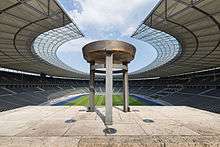
.jpg)
.jpg)
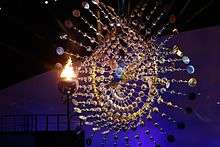
The cauldron and the pedestal are always the subject of unique and often dramatic design. These also tie in with how the cauldron is lit during the Opening Ceremony.
- In Los Angeles in 1984, Rafer Johnson lit a wick of sorts at the top of the archway after having climbed a big flight of steps. The flame flared up a pipe, through the Olympic Rings and on up the side of the tower to ignite the cauldron.
- In Barcelona in 1992, Antonio Rebollo, an archer, shot a flaming arrow over the cauldron to light it. Though Rebollo intentionally overshot the cauldron,[35] his arrow still lit it by igniting the gas rising from the cauldron. This at least has always been the official version.[12] Unofficial videos seem to indicate that the flame was lit from below.[36][37] Twenty years after the Barcelona Games one of those involved said that the flame was "switched on" ("Se encendió con un botón", in Spanish).[38]
- In Atlanta in 1996, the cauldron was an artistic scroll decorated in red and gold. It was lit by boxing legend Muhammad Ali, using a mechanical, self-propelling fuse ball that transported the flame up a wire from the stadium to its cauldron.[39] At the 1996 Summer Paralympics, the scroll was lit by paraplegic climber Mark Wellman, hoisting himself up a rope to the cauldron.
- For the 2000 Summer Olympics in Sydney, Cathy Freeman walked across a circular pool of water and ignited the cauldron through the water, surrounding herself within a ring of fire. The planned spectacular climax to the ceremony was delayed by the technical glitch of a computer switch which malfunctioned, causing the sequence to shut down by giving a false reading. This meant that the Olympic flame was suspended in mid-air for about four minutes, rather than immediately rising up a water-covered ramp to the top of the stadium. When it was discovered what the problem was, the program was overridden and the cauldron continued up the ramp, where it finally rested on a tall silver pedestal.
- For the 2002 Winter Olympics in Salt Lake City, Utah, United States, the cauldron was lit by the members of the winning 1980 US hockey team. After being skated around the centre ice rink there in the stadium, the flame was carried up a staircase to the team members, who then lit a wick of sorts at the bottom of the cauldron tower which set off a line of flames that travelled up inside the tower until it reached the cauldron at the top which ignited. This cauldron was the first to use glass and incorporated running water to prevent the glass from heating and to keep it clean.
- For the 2004 Summer Olympics in Athens, the cauldron was in the shape of a giant olive leaf which bowed down to accept the flame from windsurfer Nikolaos Kaklamanakis.[40]
- In the 2006 Winter Olympics in Turin, Stefania Belmondo placed the flame on an arched lighting apparatus, which initiated a series of fireworks before lighting the top of the 57 metres (187 ft) high Olympic cauldron, the highest in the history of the Winter Olympic Games.[41]
- In the 2008 Summer Olympics in Beijing, the cauldron resembled the end of a scroll that lifted out from the stadium rim and spiralled upwards. It was lit by Li Ning, a Chinese gymnast who was raised to the rim of the stadium by wires. He ran around the rim of the stadium while suspended and as he ran, an unrolling scroll was projected showing film clips of the flame's journey around the world. As he approached the cauldron, he lit an enormous wick, which then transferred the flame to the cauldron. The flame then spiralled up the structure of the cauldron before lighting it at the top.[42]
- In the 2010 Winter Olympics at Vancouver, British Columbia, Canada, athletes Catriona Le May Doan, Steve Nash, Nancy Greene and Wayne Gretzky were to simultaneously light the base of poles, which would then carry the flames upwards to the cauldron. However, only three out of four poles came out of the ground due to mechanical problems, resulting in inadvertently excluding Le May Doan from lighting it with the other three athletes. Because the site of the ceremonies - BC Place - was a domed stadium, Gretzky was sent via the back of a pick-up truck to a secondary site — the Vancouver Convention Centre which served at the International Broadcast Centre for these Olympics — to light a larger cauldron of a similar design located outdoors, as Olympic rules state that the flame must be in public view for the entirety of the Olympics. In the closing ceremonies, Le May Doan took part in a joke about the mechanical glitch, and she was able to light the fully raised fourth pole and have the indoor cauldron relit.
- The 2012 Summer Olympics flame in London was carried by Sir Steve Redgrave to a group of young British athletes. The group of seven, nominated by British Olympic champions, each lit a single tiny flame on the ground, igniting 204 petals, one for each competing nation or territory during the Parade of Nations.[43] Mounted on long, hinged arms, the petals were raised and converged to form the Olympic cauldron. The cauldron that traditionally flames continuously from the opening until the closing ceremony was temporarily extinguished (the flame itself was transferred to a lantern)[44] prior to the athletics events while the cauldron was moved to the southern side of the stadium. It was relit by Austin Playfoot, a torchbearer from the 1948 Olympics.[45] In contrast to the cauldrons in Vancouver, the cauldron was not visible to the public outside the stadium. Instead, monitors had been placed throughout the Olympic Park showing the public live footage of the flame.
- For the 2014 Winter Olympics in Sochi, Russia, the cauldron was situated directly outside Fisht Olympic Stadium, the ceremonial venue for the Games. After the torch's lap around the stadium, hockey great Vladislav Tretiak and decorated figure skater Irina Rodnina carried the torch outside the stadium to light a larger version of the "celebration cauldron" used in the main torch relay at the center of the Olympic Park. A line of gas jets carried the flame from the celebration cauldron up the main cauldron tower, eventually lighting it at the top.
- For the 2016 Summer Olympics in Rio de Janeiro, Brazil, the cauldron was lit inside the Maracanã Stadium, the ceremonial venue for the Games, by Brazilian marathoner Vanderlei de Lima. As part of these Games' appeal towards environmental protection, organizers deliberately chose to use a basic design with a smaller flame than past cauldrons. To compensate for the smaller cauldron, it is accompanied by a larger kinetic sculpture designed by Anthony Howe. A public cauldron was lit in a plaza outside the Candelária Church following the opening ceremony.[46][47][48]
Torch relays
- 1936 Summer Olympics torch relay
- Cancelled 1940 Summer Olympics torch relay
- 1948 Summer Olympics torch relay
- 1952 Winter Olympics torch relay
- 1968 Summer Olympics torch relay
- 1976 Summer Olympics torch relay
- 1984 Summer Olympics torch relay
- 1996 Summer Olympics torch relay
- 2000 Summer Olympics torch relay
- 2002 Winter Olympics torch relay
- 2004 Summer Olympics torch relay
- 2006 Winter Olympics torch relay
- 2008 Summer Olympics torch relay
- 2008 Summer Paralympics torch relay
- 2010 Winter Olympics torch relay
- 2010 Winter Paralympics torch relay
- 2010 Summer Youth Olympics torch relay
- 2012 Summer Olympics torch relay
- 2014 Winter Olympics torch relay
- 2016 Summer Olympics torch relay
See also
| Wikimedia Commons has media related to Olympic torches. |
| Wikinews has related news: Protests surround Olympic torch relay |
- Eternal flame
- Flame of Hope (Special Olympics)
- International Olympic Committee
- Olympic symbols
- Olympic Oath
- Queen's Baton Relay, an analogous relay associated with the Commonwealth Games
- Pan American Torch, a torch relay associated with the Pan American Games
- Asian Games Torch, a torch relay associated with the Asian Games
- The Olympic flame has been used as a symbol and main motif numerous times in different commemorative coins. A recent sample was the 50th anniversary of the Helsinki Olympic Games commemorative coin, minted in 2002. In the obverse, the Olympic flame above the Earth can be seen. Note that Finland is the only country highlighted, as the host of the 1952 games.
Notes
- ↑ Britannica on Olympic flame
- ↑ "Hitler's Berlin Games Helped Make Some Emblems Popular". Sports > Olympics. The New York Times. 14 August 2004. Archived from the original on 24 April 2009. Retrieved 27 March 2010.
- ↑ "Olympic Torch Relay history". London 2012 Olympic Games. Retrieved 25 July 2012.
- ↑ Ranger, A. "The Panathenaic". http://www.panathenaicstadium.gr/thepanathenaicstadium/history/tabid/96/language/en-us/default.aspx. Panathenaic Stadium 2011. Retrieved 14 July 2016. External link in
|website=(help) - ↑ Official website of the Olympic Movement Retrieved 19 May 2012
- ↑ (secondary)Jean-Pierre Vernant - Hestia - Hermes : The religious expression of space and movement among the Greeks Retrieved 19 May 2012
- ↑ "Amsterdam 1928". Olympic.org. Retrieved 9 July 2012.
- ↑ Hines, Nico (7 April 2008). "Who put the Olympic flame out?". London: timesonline.co.uk. Retrieved 7 April 2008.
- ↑ 施幸余乘龍舟傳送火炬 (in Chinese). Singtao. 2 May 2008. Retrieved 2 May 2008.
- 1 2 "Montréal". The Olympic Museum Lausanne. International Olympic Committee. Archived from the original on 2002-02-08.
- ↑ "Report" (PDF). 2008.
- 1 2 Official Report of the 1992 Summer Olympics, Vol. 4, p. 70 (confirming arrow lit the gas above the cauldron) and p. 69 (time-lapse photo of lighting; the arrow passed through the upper reaches of the flame).
- ↑ Winn, L.: Olympic Design: Torches & Cauldrons. Sports Illustrated, 17 Feb 2010.
- ↑ The Olympic Torch Relay: Olympic Torch Relay Highlights
- ↑ Zinser, Lynn (27 March 2009). "I.O.C. Bars International Torch Relays". The New York Times. Retrieved 3 August 2012.
- 1 2 3 "Torch Timeline". BBC News online. 18 May 2011.
- ↑ Byron, Lee; Desantis, Alicia (9 February 2010). "Passing the Torch: An Evolution of Form". New York Times.
- ↑ "Pictures of all Olympic Summergames Torches". olympic-museum.de.
- ↑ "Olympic Torch, London 1948". Metalwork. Victoria and Albert Museum. Retrieved 19 November 2007.
- ↑ "1948 Olympics" (PDF). Flight (Here and There ed.): 90. 22 July 1948.
- 1 2 "Olympic torch technology". Australian Broadcasting Corporation. 2000.
Australian runner, Ron Clarke carried a spectacular, fizzling flame into the Melbourne Olympic Stadium in 1956 only to miss out on the ceremony having his magnesium burns dressed.
- ↑ How Olympic Torches Work
- ↑ "Designing an Olympic 'torch for our time' (2012)". BBC News online. 8 June 2011.
- ↑ "Olympic Underwear Relay". The Birdman. Archived from the original on 13 April 2008. Retrieved 6 April 2008.
- ↑ Stephen Fry (2007). QI Presents: Strictly Come Duncing (DVD). Warner Music Entertainment.
- ↑ Turpin, Adrian (8 August 2004). "Olympics Special: The Lost Olympians (Page 1)". Find Articles, originally The Independent on Sunday. Archived from the original on 13 April 2008. Retrieved 6 April 2008.
- ↑ Lews, Paul; Kelso, Paul (7 April 2008). "Thousands protest as Olympic flame carried through London". The Guardian. Retrieved 18 May 2011.
- ↑ "PROTESTERS PUT OUT THE OLYMPIC TORCH IN RIO". Retrieved 2016-07-29.
- ↑ (French) "Flamme olympique: ce qui s'est vraiment passé à Paris", L'Express, 8 April 2008
- ↑ "Paris protests force Olympic flame to be extinguished". This is London. 4 April 2008. Retrieved 19 April 2008. External link in
|publisher=(help) - ↑ "China condemns Olympic torch disruptions", France 24, 8 April 2008
- ↑ "Paris protests force cancellation of torch relay.". msnbc.com. 7 April 2008. Retrieved 7 April 2008.
- ↑ "The Olympic torch". Entertainment. How Stuff Works.
- ↑ Withnall, Adam (7 October 2013). "Got a light? Olympic flame goes out in 'wind tunnel' at Kremlin - and is reborn on the sly via a security officer's cigarette lighter". The Independent. London.
- ↑ Mathews, John (15 September 2000). "Ceremonial hall of shame". BBC Sport.
- ↑ Lighting of the cauldron, an unofficial recording on YouTube.
- ↑ Lighting of the cauldron, another unofficial recording on YouTube.
- ↑ Article in La Vanguardia newspaper, 19 July 2012.
- ↑ 1996 Atlanta Opening Ceremonies — Lighting of the Cauldron on YouTube
- ↑ 2004 picture, BBC News
- ↑ Olympic Opening Ceremony Torino 2006 - Light of Passion on YouTube
- ↑ "Builders reveal secrets of giant Olympic cauldron". China.org.cn. 13 August 2008.
- ↑ "Olympic cauldron built in 'Bond-style gadget workshop' says architect as organisers vow to make giant flame carbon neutral". Daily Mail. London.
- ↑ "Relight our fire: Stunning Olympic flame doused, relocated and relit in new home... but this time there weren't a billion people watching". Daily Mail. 30 July 2012.
- ↑ Taylor, Matthew (30 July 2012). "Olympic cauldron relit after move to southern end of stadium". The Guardian. London.
- ↑ "Diminutive Rio 2016 cauldron complemented by massive kinetic sculpture". Dezeen. Retrieved 11 August 2016.
- ↑ "Sun sculpture and cauldron light up Olympic ceremony...". The Telegraph. 6 Aug 2016.
- ↑ "Formerly homeless boy who lit Olympic cauldron now has 'beautiful life'". CBC News. Retrieved 22 August 2016.
References
- Volker Kluge. 1997-2004. Olympische Sommerspiele – Die Chronik. Five volumes. Sportverlag except Vol. 5 (Südwest-Verlag). ISBN 3-328-00715-6; ISBN 3-328-00740-7; ISBN 3-328-00741-5; ISBN 3-328-00830-6; ISBN 3-517-06732-6.
External links
- Official site of the Olympic Movement - Images and information on every game since 1896
- IOC brochure on the history of Olympic flame (1 MB PDF)
- TorchRelay.net - Torch Relay coverage. Includes torchbearer profiles, photos, videos, and more.
- Athens Info Guide - A list of past torches
- Sondre Norheim - on the three occasions when the Olympic flame was lit in Morgedal
- BBC article on the history of the torch
- The Nazi Olympics: Berlin 1936 - online exhibition
- Live feed of current torch relay